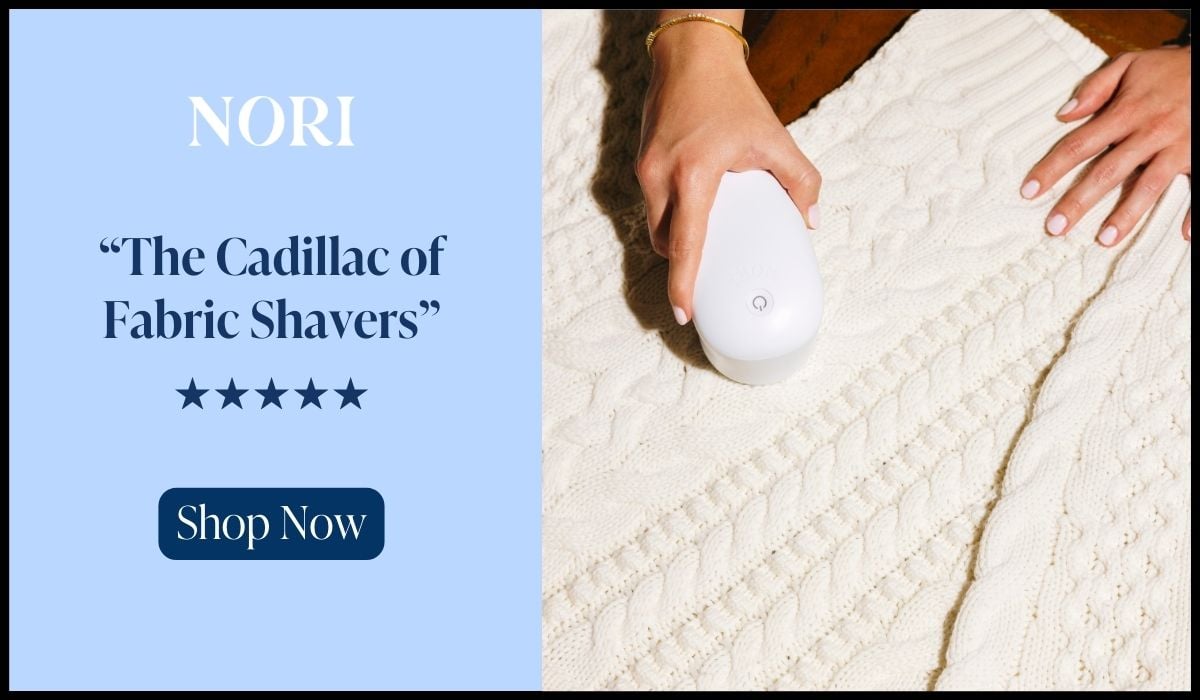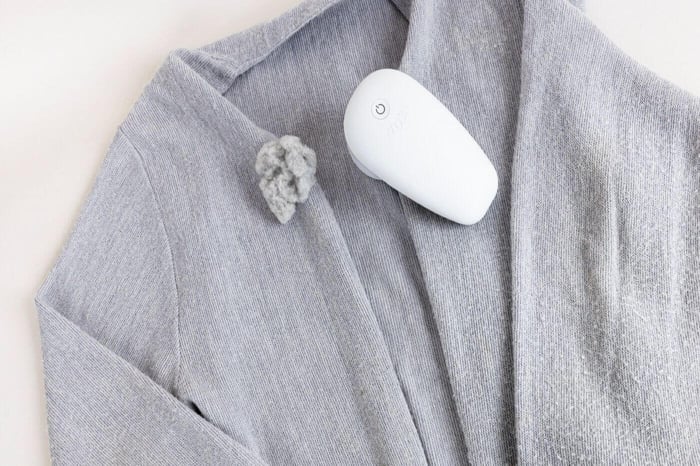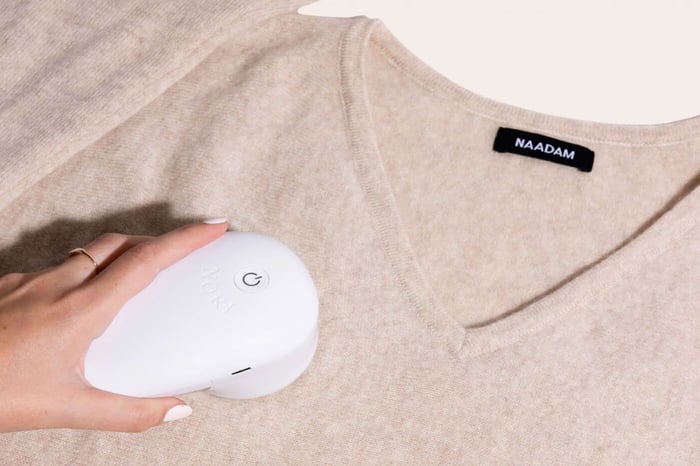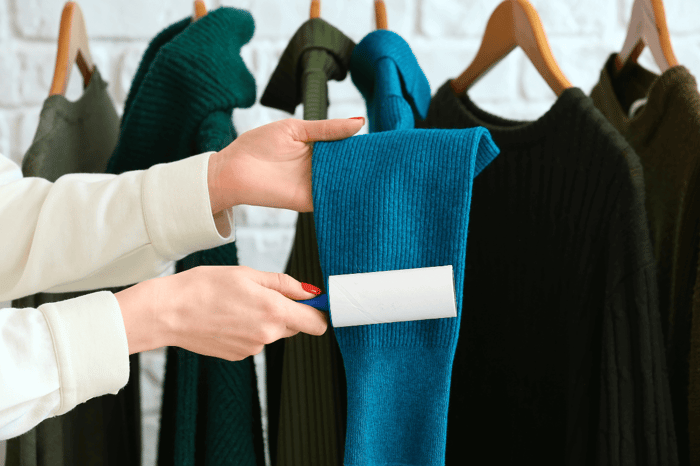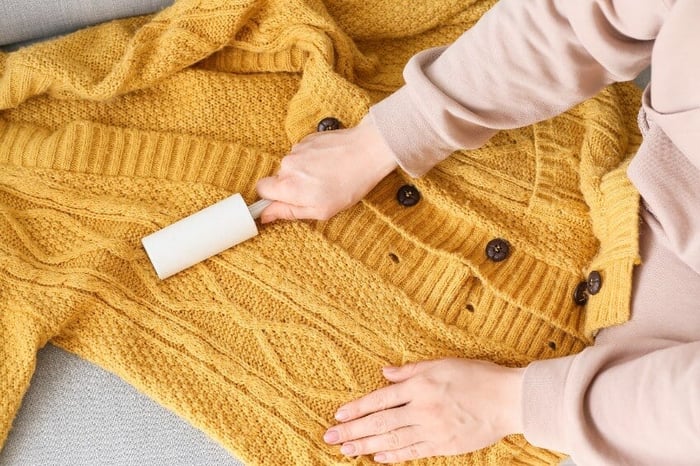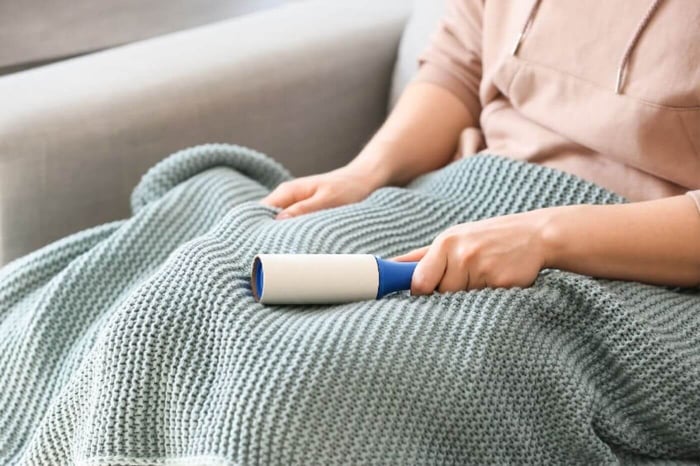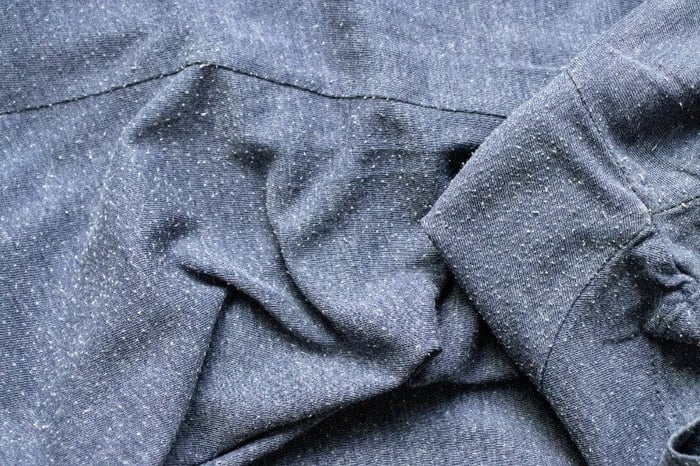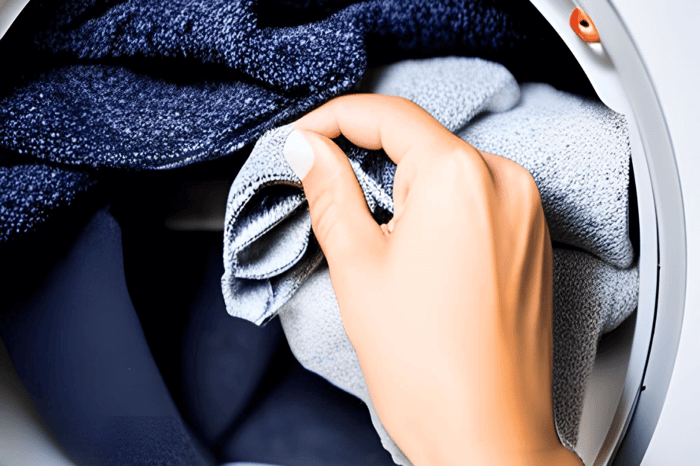
Lint is one of those things that everyone hates. We see it everywhere we go, and even though we know how to avoid it, we still end up getting some. But what causes lint? And how can we stop it? Few things are more frustrating than trying to get rid of lint and pills on your clothes. Not only is it a hassle, but it can also make your clothes look old and worn out, reducing their life. Fortunately, there are some easy steps you can take to prevent pilling and get lint off clothes, such as using the Nori Trim.
In this article, we will discuss how to prevent pilling and how to get lint off clothes. Read on for helpful tips that will keep your clothes looking their best!
Use discount code “SHOP10” at checkout to save 10% on The Nori Trim!
Lint is tiny pieces of fabric that come off of clothing during wear and tear. There are three main types of lint: dust, hair, and thread. Dust is the most common type of lint and is made up of small loose fibers that come off of clothing or that our clothing just picks up from the environment. Hair is the second most common type of lint and is made up of shed hair from both people and animals. Thread is the third type of lint and is made up of small pieces of thread that come off of clothing.
The best way to get lint off clothes is to wear clean clothes. Washing your clothes regularly helps keep them clean, but if you’re wearing something that has built up too much lint, try removing the lint before washing. If you’re having trouble removing lint, try following these quick steps to get lint off clothes:
-
Wash your clothes in cold water. Cold water creates less friction, making it easier to remove lint.
-
Use a lint roller. A lint roller works like a vacuum cleaner, sucking up lint and dust particles. You can use a lint roller to remove lint from your clothing.
-
Avoid using fabric softeners when washing clothes that may attract lint. Fabric softeners can leave a residue on clothing that will attract lint. Instead of fabric softener, you can use dryer sheets.
What Is Pilling on Clothes?
Pilling is the formation of small balls of fiber on the surface of a fabric. It is caused by surface abrasion and is most likely to occur on clothing that is made from wool or synthetic fibers. Pilling can also be caused by laundering if the fabric is not washed correctly. Pilling is a cosmetic issue and does not affect the performance of the fabric.
How Does Pilling Occur?
Pilling occurs when tiny fibers are rubbed off the surface of the fabric. The rubbing action can come from normal wear and friction. If you wear your clothes for long periods of time, they will naturally pill over time. Pilling can also be caused by laundering if the fabric is not washed correctly. Pilling is a cosmetic issue and does not affect the performance of the fabric.
How to Prevent Pilling on Clothes?
The best way to prevent pilling is to avoid friction. If you know that your clothes are likely to pill, take them off before they have a chance to rub against something else. You can also try wearing a layer underneath your clothing to protect it from abrasion.
Another way to prevent pilling is to choose fabrics that are less likely to pill. Natural fibers like cotton and linen are less likely to pill than synthetic fibers like polyester and nylon. Preventing pilling is particularly important for knits to maintain their appearance and longevity.
What is Lint?
Lint is a type of fabric debris that can accumulate on clothing. It is typically composed of tiny loose fibers that come off the fabric during wear and can become trapped on the fabric's surface. It is made up of shed fibers from fabric and can be either natural or synthetic.
Lint can also be caused by static electricity, which can cause the fabric fibers to cling together. Lint can be difficult to remove from clothing, and can often cause the fabric to become misshapen or damaged if allowed to accumulate.
There are two main types of lint: fabric lint and hair lint.
-
Fabric lint is made up of fibers that have come off of the fabric itself or the environment. This type of lint is often found on clothing that is made of wool or other natural fibers.
-
Hair lint is made up of shed hair from both humans and animals. This type of lint is often found on clothing that is made of all types of fabric.
Difference Between Lint and Pilling
Lint is small pieces of fabric or fibers that come off of clothing. Pilling is when those same small pieces of fabric or fibers form balls on the surface of clothing. The difference between the two is that lint is loose and not attached to anything, while pilling is when the fibers are all tangled together.
Lint can sometimes be removed by simply brushing it off, while pilling typically requires a little more work to remove. Piling on clothes is often caused by wear and tear on the fabric. Also, clothing that may fit too tightly can pill more quickly depending on the fabric.
How to Prevent Pilling and Lint on Clothes 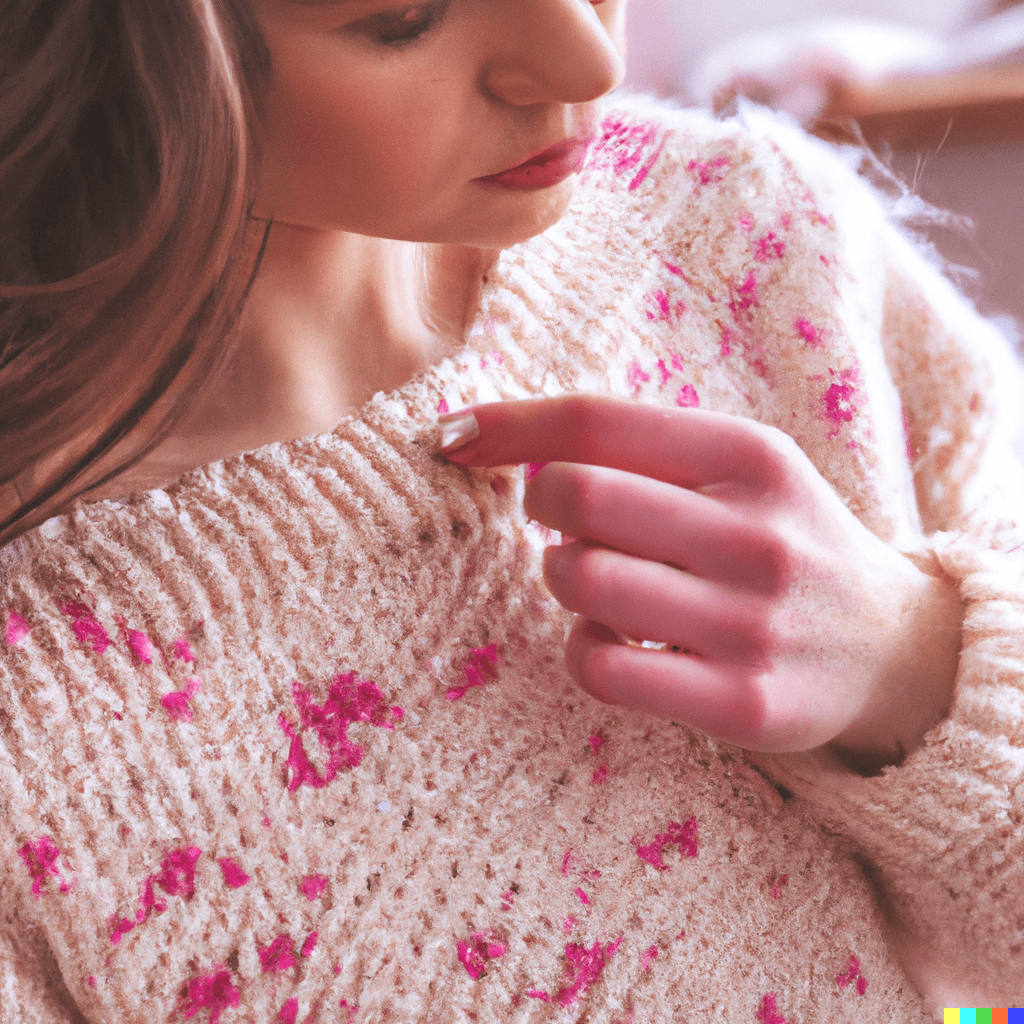
Pilling happens when fibers from the garment begin to create small rolls or piles of fabric, This causes the garment to create small lumps or pills. Lint happens when fabric rubs against another surface and creates tiny pieces of fabric.
Here are some tips to prevent pilling and remove lint from your clothes:
1. Use a fabric shaver.
A fabric shaver is a handheld device used to shave down lint and pilling buildup on clothing. You simply run the shaver along the item and watch the pills go away. Shaving lint is a great way to keep your clothing looking new. Fabric shavers can be manual or battery-operated, often requiring two AA batteries for portable use. Additionally, ensure the fabric shaver has a protective cover to shield the rotating blade, which helps prevent damage to the fabric and ensures user safety. We recommend trying The Nori Trim.
2. Use a steam iron.
If a piece of clothing has lots of lint and you don’t have enough time to wash it, then you could steam it using a clothes-steaming device like the Nori Press. The moisture from the water will help reduce the static electricity that keeps the lint stuck to the fabric. We recommend trying The Nori Press.
3. Use a lint brush.
A lint brush is a tool designed specifically to remove lint from clothing. It works best on heavy lint buildup. Place the bristles of the brush against the item and gently move it across the area where the lint is located.
4. Use a lint comb.
A lint comb is similar to a lint brush, except it has teeth made of nylon or polyester. Just like a lint brush, use the teeth of the comb to remove lint from your clothing.
5. Use a lint roller.
A lint roller is another tool designed to remove lint from clothes. It consists of a handle with a roller of sticky tape at the end. The sticky tape is in sheets and as each sheet fills with lint or pet hair you simply peel it off to expose a fresh sheet of sticky tape.
6. Use a dryer sheet.
Dryer sheets are available in most stores. Simply rub the dryer sheet onto the item to remove lint.
8. Use a damp cloth.
Damp clothes are often recommended by professionals who work with textiles. Damp cloths help loosen lint so it can be easily removed. Simply soak a cloth in warm water and wring it out before wiping it across the item to remove the lint.
9. Use a toothbrush.
When in a hurry, you can use a toothbrush to remove lint.
10. Use a hair dryer.
If that’s all that’s around, a hair dryer can help to remove lint from clothing made up of a smooth fabric.
11. Use a wet/dry vacuum.
Wet/dry vacuums are powerful machines that suck up dirt and debris. They’re perfect for removing lint from carpeted areas such as living rooms and bedrooms. Wet/dry vacuums come with attachments that allow them to pick up lint.
12. Use a microfiber cloth.
Microfiber cloths are ideal for removing lint from any type of surface. These cloths are very gentle on surfaces and won’t scratch or damage furniture.
To remove lint from your clothing, start by wetting the microfiber square. Then, rub the wet square over the linty area in a circular motion. Continue rubbing until the lint is gone. Finally, rinse the square and allow it to air dry.
13. Use scotch tape.
If all that’s around is a roll of scotch tape, then you’re in luck! Tear off a piece and begin!
14. Use an air blower.
An air blower is a handy tool for blowing dust and other particles from carpets and floors. An air blower also helps remove lint from clothing and furniture.
15. Use a vacuum cleaner.
Vacuum cleaners are useful tools for cleaning carpets and hardwood floors. Vacuum cleaners are also helpful for removing lint from clothing and other items. A vacuum cleaner can be used to remove lint from fabric by using the attachment that is specifically designed for this purpose. The vacuum cleaner should be set to the lowest setting so that the fabric is not damaged. The attachment is placed over the lint and the vacuum cleaner is turned on. The lint will be drawn into the attachment and the fabric will be left clean.
FAQs About How To Prevent Pilling and Get Lint Off Clothes
Will a fabric shaver remove both pilling and lint?
A fabric shaver like the Nori Trim removes both pilling and lint, but it's important to use it in the right way. First, make sure that the fabric shaver is clean. If it's not clean, the accumulated fuzz and lint will just get transferred to your clothes. Second, hold the fabric shaver at a 90-degree angle to the fabric. This will ensure that you get the best results. Finally, move the fabric shaver back and forth in a smooth motion. Don't apply too much pressure or you'll damage the fabric.
Can I use a Single-Edged Razor to remove lint from clothes?
You can use a single-edged razor to remove lint from clothes, but it is not the best tool for the job. A lint brush is a better tool for removing lint from clothes because it is designed to remove lint.
Can I use scissors to remove pilling from clothes?
There are a few ways you can use scissors to remove pilling from clothes. One way is to lay the clothing item flat on a surface and gently glide the scissors over the areas with pilling. Another way is to hold the clothing item up and snip at the linty areas. Whichever method you choose, be sure to go slowly and be careful not to cut the clothing.
Can I use a Mr. Clean Magic Eraser to remove lint from my clothes?
To start, you will want to gather your supplies which include the Mr. Clean Magic Eraser, water, and your clothes that have lint on them. Once you have everything, dampen the Mr. Clean Magic Eraser with water and then start rubbing it on the areas of your clothing that have lint on them. Be sure to rub in a circular motion and use moderate pressure. You will want to keep doing this until the lint is no longer on your clothing. Afterward, you can throw away the Mr. Clean Magic Eraser.
How can I use a comb with fine teeth to remove lint from clothes?
A comb with fine teeth can be used to remove lint from clothes by gently running the comb over the surface of the clothing. The comb will catch any lint that is on the surface of the clothing and remove it.
How do I prevent fabric pilling?
To prevent fabric pilling, you should avoid rubbing the fabric against itself or other surfaces. You should also avoid wearing clothing made from delicate fabrics such as wool or silk. Instead, opt for clothing made from tougher fabrics such as denim or corduroy. If you must wear clothing made from delicate fabrics, be sure to take extra care when putting it on and taking it off. Also, avoid washing your clothes in hot water or drying them in a hot dryer. Instead, wash them in cold water and air dry them.
What about lint and using the washer/dryer?
Avoid overloading the washing machine. Overloading the washing machine can also cause pilling. When clothes rub together in the washing machine, it can create friction that leads to pilling. So make sure you don't overload the washing machine and only wash a few items at a time.
Dry clothes outside, when possible. Outside, air moves around freely. This makes it easy for dust particles and small pieces of debris to float away. Inside, however, everything stays close together. Because of this, lint tends to collect faster.
Can I use a netting lint catcher to remove lint from my clothes?
Yes, you can use a netting lint catcher to remove lint from clothes. The netting will catch the lint and prevent it from being transferred to the clothes.
Does washing clothes with vinegar help remove lint and pilling?
Yes, vinegar can help to remove lint and pilling from clothes. To use vinegar for this purpose, simply add a cup of vinegar to your washing machine along with your regular detergent. Run the cycle as usual and your clothes should come out free of lint and pilling.
What about using an anti-static spray?
Lint happens when two surfaces rub against each other. Static electricity builds up between those surfaces, causing it to cling together. When you touch something like a doorknob, you transfer some of that static charge to the surface. If there are no charges on the surface, it won't stick to you. But if there are already electrons on the surface, they'll want to move around, and you'll end up sticking to whatever you're touching.
Antistatic sprays reduce the amount of friction between two surfaces, thus preventing linting. They work by creating a layer of positive ions over the surface being sprayed. These positively charged particles attract negatively charged particles from nearby surfaces, making them less likely to cling to one another.
This spray works best on smooth surfaces, such as plastic, glass, metal, leather, and wool. It doesn't work well on fabrics, though, since the fabric itself contains negative charges. So you'd still need to use a separate antistatic spray on clothes.
Use discount code "SHOP10" at checkout to save 10% on The Nori Trim!
Which types of garments are most likely to cause lint?
Lint is one of those things you just don't want to see on yourself. But it happens anyway. And while there are many different types of fibers used in clothing, some are much worse than others when it comes to causing lint.
Lint is made of dead human skin cells and dust particles stuck together. Lint production depends on several factors including the type of fabric, whether it gets washed frequently, and how long it stays unwashed before being washed again. Clothing that produces lint or collects lint is likely to irritate sensitive areas such as the eyes, nose, throat, and lungs.
Will dry cleaning remove lint balls?
Many people think that dry cleaning is the best way to clean lint ball stains out of their clothing. Dry cleaning doesn't always work very well.
Tips to Prevent Lint Buildup on Your Clothes
Lint is mostly formed during textile manufacturing. Different fibers absorb different amounts of lint, and cotton absorbs less lint than synthetic fibers like polyester. If you wash your clothes regularly, there won't be too much lint on them. However, lint can build up over time. Here are some tips to help prevent the buildup of lint on your clothes:
-
Use a dryer sheet to reduce static electricity.
-
Wash your clothes separately. This helps prevent lint from building up on one garment while another is being washed.
-
Dry your clothes inside out. This prevents moisture from getting trapped under the material. When wet, lint sticks to the surface.
-
Keep your washing machine clean. A dirty machine attracts dirt and lint. Cleaning the machine once every three months will help keep it running smoothly.
-
Make sure your detergent contains no added softeners. These products tend to attract lint.
-
Buy quality fabric. Quality fabrics are worth every penny because they last longer and look better. If you buy cheap clothes, you'll end up spending money replacing them sooner rather than later. You don't have to spend thousands of dollars on designer brands either. There are plenty of affordable options out there.
-
Avoid Fiber Blends. Fiber blends are becoming increasingly popular because they're cheaper than buying pure fibers. But there's one big problem — they don't work nearly as well as you might think. In fact, they can actually make it harder for your clothes to dry properly. The reason why? When you buy a blend, you're basically getting a mixture of different types of fiber. This creates friction, which causes static electricity.
-
Choose Tight Woven Fabrics. Loose knit fabrics will allow loose threads to come out easily. Tighter knit fabrics keep threads together. They're usually made from yarn, whereas woven fabrics are constructed from weaving. Knitted fabrics are often used for socks, sweaters, scarves, and mittens. While you might think that knit fabric is just for babies' clothes, it's actually found in everything from sportswear to outerwear. For example, some jackets are made from a knitted fabric called "piqué." This type of fabric is typically used for jackets, coats, and vests. Woven fabrics are generally used for clothing like shirts, pants, dresses, skirts, and suits. These types of garments are made up of different fibers such as cotton, wool, silk, linen, rayon, and nylon. Some examples of woven fabrics include denim, twill, poplin, gabardine, satin, corduroy, chambray, and flannel.
-
Choose natural fibers if possible. Natural fibers are less likely to produce lint than synthetics. This makes it easier to maintain cleanliness and comfort in clothing. However, if you need to avoid allergies, choose synthetic materials.
-
Protect your clothes. The most important thing you can do to protect your clothes from seat belt wear is to use a padded cover. If you don't have one, you'll want to find a way to attach it to your seat belt. Seat belts are designed to fit snugly around the body, so there's no room for anything else. A padded cover will keep your clothes out of harm's way.
-
Use a seat belt with a covering to prevent damage to your clothes. When you're wearing a seat belt, the shoulder strap rests against your chest. As long as you're wearing a padded cover, you won't feel the weight of the strap pressing down on your shirt. But if you don't have a cover, the pressure could cause permanent creases in your clothing.
Conclusion
We hope this article helped you to learn more about how to prevent pilling and get lint off clothes. Make sure you use a detergent without added softeners, buy quality fabrics, avoid fiber blends, choose tightly woven fabrics, and if possible, choose natural fibers. Additionally, you can protect your clothes by using a padded seat belt cover or attaching one to your seat belt. Finally, try not to wear the same clothing more than once without washing it in between. This will help reduce the amount of lint that accumulates over time.
And if your clothes are already filled with lint and you want to get lint off clothes, use the Nori Trim to effectively eliminate this. Shop the Nori Trim today!
